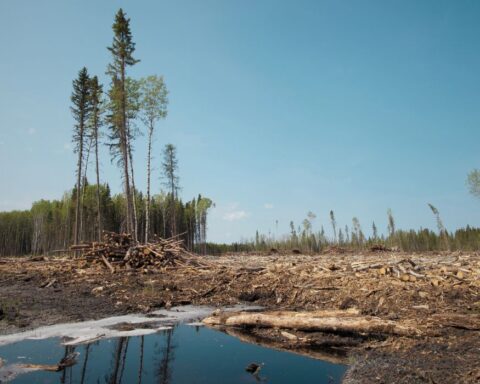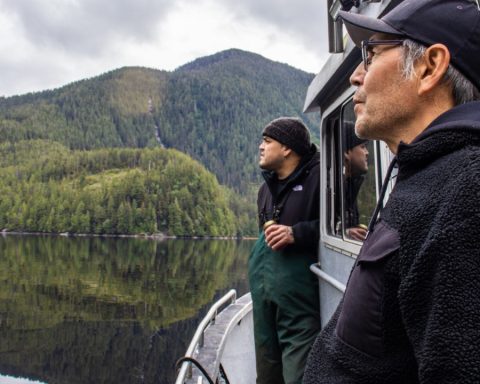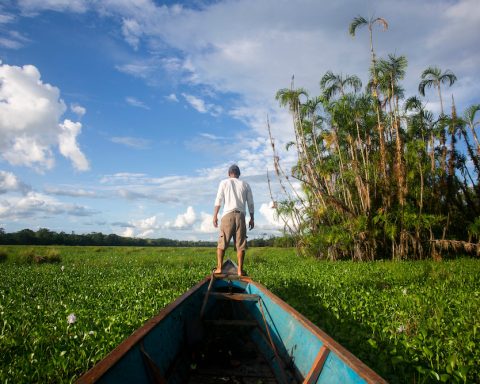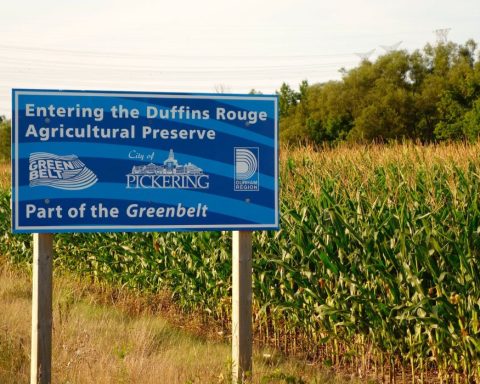If the world’s forests could talk, what would they say about their health in the 21st century?
Would they raise concerns about the rise in forest fires attributed to climate change, or how the Mountain Pine Beetle and Emerald Ash Borer are threatening their survival? Would they remind us how important they are as a carbon sink?
Would they lecture some countries for treating them carelessly, and praise others for being more responsible and helping them regenerate?
Forests can’t talk, of course, so the best we can do is shine a light on their wounds and observe how they’re healing. That’s the idea behind Corporate Knights’ first Country Canopy Index, which looks at the world’s biggest deforesters from a variety of perspectives and identifies those countries that need to do a better job.
We wanted to call this report the “Lorax Index” – the Lorax, after all, speaks for the trees – but lawyers representing Dr. Seuss Enterprises denied us permission to leverage the name of its client’s “much-beloved property.” No matter, the spirit of the Lorax lives on in this report, which was made possible by Global Forest Watch, an online tool launched last February by the World Resources Institute and partners including Google and the University of Maryland.
What this free, publicly accessible tool does is empower users to monitor tree loss around the world. Through a combination of satellite technology, mapping software, open data and crowdsourcing, any person with an Internet connection is guaranteed timely and reliable information about forests for the first time, no matter the location.
Corporate Knights used the tool to look at how the world’s forests have done in the 21st century – specifically between 2000 and 2012. We focused on countries where forests have been most impacted, and where forests have the most impact.
Countries were assessed across five indicators: absolute trees loss, absolute tree gain, loss as a percentage of total forest coverage, loss per capita, and loss per billion dollars of GDP. The results from these indicators were used to calculate a final index score for the 12 countries assessed, which collectively represent about 65 per cent of the world’s forests and 62 per cent of total observable tree loss this century.
(Scroll to the bottom of this article for a closer look at our methodology, assumptions and caveats).
Renewable natural capital
 We know that forests are an integral part of the world’s natural capital, and that they supply us services that carry a value. We take trees for granted, but consider that worldwide forest wealth is estimated at more than $273 trillion (U.S.), much of it concentrated in a dozen or so countries, according to the Inclusive Wealth Report 2014, a joint initiative of the United Nations University and United Nations Environment Programme.
We know that forests are an integral part of the world’s natural capital, and that they supply us services that carry a value. We take trees for granted, but consider that worldwide forest wealth is estimated at more than $273 trillion (U.S.), much of it concentrated in a dozen or so countries, according to the Inclusive Wealth Report 2014, a joint initiative of the United Nations University and United Nations Environment Programme.
Their document, released in December, cites “alarming losses” of forest capital in most countries over the past 20 years. “From an accounting perspective, these losses are frequently hidden from view,” write report co-authors Haripriya Gundimeda, a professor at the Indian Institute of Technology Bombay, and Giles Atkinson of the London School of Economics and Political Science.
They concede that natural capital accounting of forest assets remains a “work in progress,” but even rudimentary analysis shows that forest capital is a significant component of our total wealth. “Many countries appear to be losing significant amounts of this wealth,” Gundimeda and Atkinson warn.
Our Country Canopy Index makes this conclusion alarmingly clear. In the first 12 years of this century, just five countries – Brazil, Canada, Indonesia, Russia and the United States – saw 117 million hectares of tree loss. This is roughly equivalent to the entire land area of Ontario, and represents about half of all tree loss this century.
The biggest single-country loss of tree cover was seen in Brazil, though Indonesia is now losing forests at a faster rate due to illegal harvesting. Recognizing the severity of the problem, Indonesia’s new president, Joko Widodo, pledged in November to crack down on deforestation, a move that was applauded by Greenpeace. (The decision by Asia Pulp and Paper in early 2013 to halt its own deforestation activities in Indonesia also bodes well for the country’s forests – see Heroes and Zeros.)
It wouldn’t be so bad if we were gaining the same density of forest cover at the same rate, either through natural growth or plantations, but that is far from the case. For every hectare of new growth in those same five countries, more than two hectares were lost. And that’s a relatively good outcome.
Bolivia, which had the worst overall score in our index, has a loss-gain ratio of 16-to-1, an unsustainable path for the Amazon basin that makes Brazil – especially in recent years – look like a treehugger by comparison. Surging deforestation in Bolivia since 2000 to support large-scale agriculture led to the tightening of land-use laws in 2013, but environmentalists have dismissed the measures as weak and ineffective.
Partial victories
Not to suggest there hasn’t been progress. It’s generally recognized that the rate of deforestation has slowed worldwide and reforestation efforts are on the rise, with developing countries from Brazil to Vietnam taking encouraging steps to tackle the problem.
 Environmental and social groups in Brazil, for example, pressured the country’s soy and cattle industries to voluntarily declare moratoriums on product grown on deforested lands. If soybeans were produced on lands deforested before June 2006, members of the Brazilian Association of Vegetable Oil Industries and the National Association of Cereal Exporters refused to buy them.
Environmental and social groups in Brazil, for example, pressured the country’s soy and cattle industries to voluntarily declare moratoriums on product grown on deforested lands. If soybeans were produced on lands deforested before June 2006, members of the Brazilian Association of Vegetable Oil Industries and the National Association of Cereal Exporters refused to buy them.
The Brazilian government also expanded the number and size of protected areas, while state and local authorities beefed up enforcement of land-use laws with the help of public prosecutors. Enforcement efforts also became more sophisticated. The country’s National Institute for Space Research began using satellite technology to monitor where and when forest changes were taking place, allowing authorities to zero in on deforestation hot spots and take swift action.
The Union of Concerned Scientists profiled several “success stories” in a June 2014 report. These countries, it said, “demonstrate how the power of political will – manifested in a range of actors across the public, private, and community spectrum – can have positive impacts on forest conservation, socioeconomic development, and forest-land use changes.”
Still, these are only partial victories at best. The bottom line is that our forests, whether by human hand or force of nature, are shrinking. It’s why the more than 30 countries and 40 large corporations that signed The New York Declaration on Forests, announced in September at the UN Climate Summit, committed to helping end natural forest loss by 2030 and cut the rate of loss in half by 2020.
Signatories also agreed to reward countries that take action to reduce forest emissions. Norway, for example, is paying $150 million to Liberia to put a halt to deforestation within its borders by 2020. The U.K. and Germany made similar financial commitments, which will help countries like Mexico, Ghana and Nepal resist the temptation to cut down their forests for economic gain.
Click to enlarge the image.
This approach is the basis of a UN program called REDD, which stands for Reducing Emissions from Deforestation in Developing Countries. The idea was proposed in 2005 by a coalition of countries led by Costa Rica and Papua New Guinea, and was embraced as a global program by the United Nations at the 2007 climate conference in Bali.
So far, argues the Union of Concerned Scientists, REDD financing “has proved to be money well spent.” Environmental groups, from The Nature Conservancy to WWF, are also supportive of the initiative. WWF says it has potential to cut gross deforestation by 75 per cent and reduce net deforestation worldwide to zero by 2020. But, the group says, “it must happen on a large scale.”
Another approach, called Payments for Ecosystem Services, is similar to REDD in that it uses money to discourage deforestation or promote reforestation. The difference is that the funds are targeted at specific people or communities.
Pointing fingers
If we were to call out those countries most responsible for or affected by global tree loss, who would it be? The most clear-cut approach is to look at the absolute loss of forest coverage, in which case Brazil, Russia, the United States, Canada and Indonesia top the pack.
But that may be an oversimplification. Looking at forest loss as a percentage of total forest cover, none of these countries top the list. Viewed this way, Malaysia’s forests appear to be under the most stress, with forest loss this century representing 22 per cent of the total forest cover it had in 2000. Indonesia followed with 15 per cent, and surprisingly, Sweden came in third at 9.2 per cent.
Should Sweden, which in 2010 had less than 4 per cent of the forest cover Russia had, escape scrutiny because it is having relatively little global impact? Or, should countries be held more accountable for forest loss within the context of their own borders?
 Another approach is to assign responsibility by population. Can Canadians feel good about the fact that since 2000 each citizen’s share of Canada’s tree loss works out to two-thirds of a hectare, more than twice the per-capita figure for second-ranked Finland and eight times the share for a U.S. citizen?
Another approach is to assign responsibility by population. Can Canadians feel good about the fact that since 2000 each citizen’s share of Canada’s tree loss works out to two-thirds of a hectare, more than twice the per-capita figure for second-ranked Finland and eight times the share for a U.S. citizen?
And compared to China? A Canadian’s share of forest loss this century is 155 times the share of a Chinese citizen. If China had the same per-capita tree loss as Canada, all of its forests would be gone – even taking the current rate of regrowth into account.
Finally, what if we assigned blame based on how economically productive countries are with their forest resources? By this measure, the Democratic Republic of Congo (DRC), Bolivia and the Central African Republic (CAR) have done most poorly. DRC, for example, lost 372,000 hectares of forest for every $1 billion of its GDP. Here, we picked GDP for 2006 (current U.S. dollars) as the mid-point for the 12 years analyzed. Bolivia and CAR each lost about 245,000 hectares.
On this metric, Canada does much better, having lost 16,196 hectares per $1 billion GDP. Even so, Canada is 10 times less productive than the United States, which lost only 1,708 hectares.
This may explain why, taking all five indicators together, Canada ranked third in our index behind Bolivia and Malaysia. Across a number of metrics, the country doesn’t perform well.
But care must be taken when attributing blame. When we talk of tree loss, we’re not strictly talking deforestation. In the context of this report, “loss” can include mechanical harvesting, but also loss due to forest fire, disease and storm damage. The pine beetle alone has had a devastating impact on some countries, particularly Canada.
In other words, this is not an indictment of any country’s logging industry. This report does, however, tell us a lot about the health of a country’s forests and how the global canopy continues to be chipped away by commercial interest, the impacts of climate change, and random acts of nature.
Methodology, assumptions & caveats:
With our analysis, we assumed greater than 50 per cent canopy density when calculating forest loss or gain, meaning that from a satellite’s perspective forests are only counted if trees are seen as covering more than half the ground. Also, vegetation must be at least five metres high.
With each indicator we ranked the 10 worst-performing countries, or 10 best in the case of forest gain. Our final “index” is based on the cumulative of what countries scored on each indicator. Overall country scores are out of 100. The lower the score the more dire the situation on the ground.
When we talk of tree loss, we’re not strictly talking deforestation. It can include mechanical harvesting, but also includes loss due to fire, disease and storm damage. In other words, this is not an indictment of any country’s forestry sector, though readers can draw their own conclusions.
Tree gain represents growth in an area that previously had no tree cover, and includes natural growth and plantations.
While individual indicators are based on safe assumptions, we recognize the methodology for our index is subjectively designed. Our goal is to simply present the data in a different way. We also recognize that not all forests are created equal. A rich and diverse old-growth forest is not equivalent to a monoculture plantation on so many levels, but comparing forest type is beyond the scope of this project.









